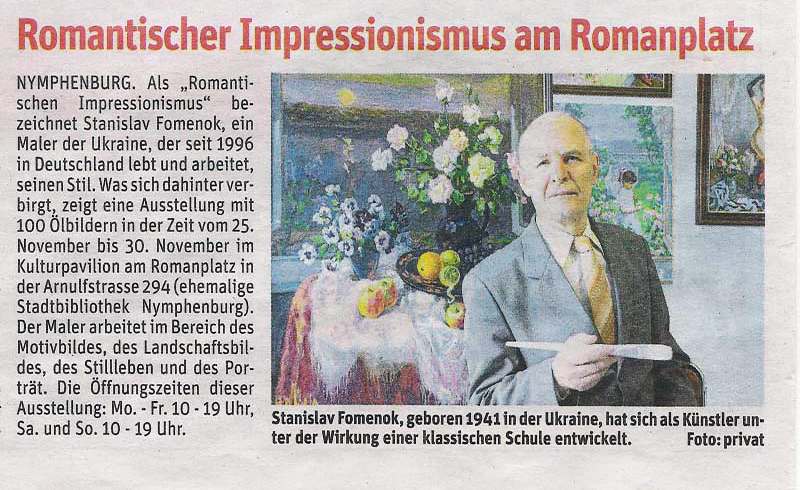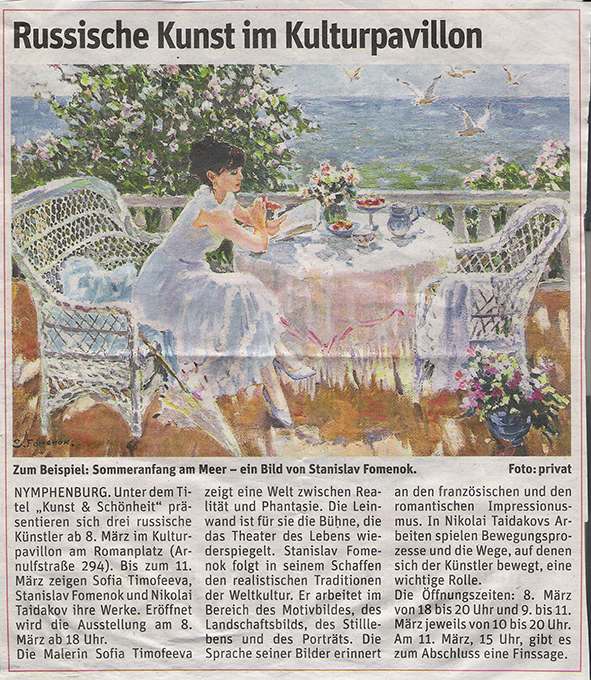Olga Shcherbyna, head scientific researcher of the museum
 Stanislav Fomenok is a person with an interesting destiny. An artist from among so-called "successful" painters. Of course, an eventful biography of the artist is an extraordinarily useful source for understanding his artistic path as well. But let us try, upon having a look at the painting by the author of the era of prevailing socialist realism and at the already "free exploration" painting, to find out where Stanislav Fomenok discovered a formula for balancing the state of being in demand and creative self-realization at different times in different circumstances.
Stanislav Fomenok is a person with an interesting destiny. An artist from among so-called "successful" painters. Of course, an eventful biography of the artist is an extraordinarily useful source for understanding his artistic path as well. But let us try, upon having a look at the painting by the author of the era of prevailing socialist realism and at the already "free exploration" painting, to find out where Stanislav Fomenok discovered a formula for balancing the state of being in demand and creative self-realization at different times in different circumstances.
While the title of a "sun worshiper" in Ukrainian literature has undoubtedly been assigned to Mykhailo Kotsiubynsky, calling Stanislav Fomenok a sun worshiper among modern painters would be well justified. Like the outstanding writer, our artist, who finds himself in the breakdown of artistic ground and facing the demands of the "new" time, prefers the "small prose", praising the beauty of life and the unanimity of a human and the nature, sometimes giving this motive certain lyrical, sometimes even symbolic features, and, at the same time, refers to the "sun" as a supertemporal, powerful visual material.
Solarness as a formality dominant feature of painting of Stanislav Fomenok is inherent in his early works, both in the "pre-Munich" mature works and the brand new canvases.
In the recent years paintings, sun-drenched landscapes, still-life paintings and nude settings, the light is a kind of carrier of mood, "the colour of the moment" and gives the pictures of etude character, impressionistic liveliness, accentuates the shimmering imperceptibility of time.
And while sunshine, being a favourite instrument of the artist, is mostly a formal expression of art in his "Munich" period works, in the thematic "Soviet" period paintings the "sunniness" can be interpreted as something sense-making.
For example, in such works as the "Spring" (1975), the "Sunny Land" (1978) and the "Peace to Our Land" (1990), the sunlight dancing over the figures, glowing reflexes, translucent shadows not only create a lively volume, but also added particular sunshine to the characters, seemingly lifting them in the painting space. The sun seems to preserve the created image, raising it to the "status" of symbolic ones, giving birth to a deeper meaning.
Combined with the competent, consistently designed composition and the perfect selection of model characters, the sun gives the paintings a touch of utopia, timelessness, helps to create a unique author's "iconography", asserting a generalized image of youth, motherhood, a happy family, the fullness of life in general, etc. in the artist's work.
In general, the composition for Stanislav Fomenok remains the main hallmark of his works. And he deals with it with consummate skill. Not just with the composition as a purely "model" arrangement in the format and the general colour solution. Indeed, this professional ability of the artist is evidenced by almost every one of his still life or landscape paintings. But with the composition as a special author's point of view, as with the direct engagement of the author in the depicted scenes.
It is, of course, referred to Stanislav's favourite genre, that is a theme-based picture. Almost every composition of the artist with an entirely, for the most part, understandable or the historical subject, extends his work beyond the plane of epic, linear narration. The theme-based paintings of the artist are gravitating, so to speak, toward a small prose, but in painting. The artist's shift from focusing on the plot to focusing on an image-bearing aspect and on building a "lyrical skeleton" of the painting is obvious.
Therefore, we can say that every "story" by Stanislav Fomenok is rather a prose poem – that is a poem written in prose. To catch the spirit, the state of the image – this is a super task. To make the image speak, rather than the characters or models. Even on serious topics, historical themes. For example, "The Stout-Hearted. Ivan Franko, Mykhailo Kotsiubynsky, Lesia Ukrainka" (sketch, 1973), "We Prepared the Horses for the March" (sketch, 1976), "In the Forest near the Front" (1983), "After the Battle" (sketch, 1985), where a historical event becomes a context. Documentation gives way to expressive imagery, enhanced by the mass of colours, selected by the author.
In the large-scale subject paintings by Stanislav, horizon is of particular significance for creating a perfect composition. It is the horizon that sometimes gives away the author's presence in the picture, or slightly lifting the recipient above the scene depicted. Thus, the artist's horizon is often high, or missing in the plane of the painting ("Sunny Land" (1978), "Peace to Our Land" (1990), "Near the Sea" (1982 - 1983), "In the Forest near the Front" (1983), etc.).
Centreless bold locating of figures is also one of the most frequent arrangement techniques of the artist. And such a solution does not in any way aggravates or disharmonizes the composition. On the contrary - it introduces a new persona into the plot – the viewer. For example, in the "Bride" (1975), the main female character is pictured full face, and as if she poses for a family portrait. But it seems there must be another character by her side. Such a newly discovered compositional formula tunes the audience to the lyrical mood. It highlights the beautiful youth of the main character and the place next to her for "her greatest future".
In the "Dream" (1984) painting, the artist divides the working space horizontally. Leaving a significant space for other "actors" – reproductions on the wall. Therefore, they no longer look like an interior element. Rather, this is an allegorical evocation of the beauty itself – along with its real personification. And maybe that is the dream itself – a combination of two incarnations of the beauty of a woman...
In general, worshiping beauty is one of the main concepts of the works by Stanislav Fomenok. And many hymns he sang to one of the most beautiful incarnations of beauty in nature - to a woman. Here we see the admiration of the perfect "shape" of the model in numerous nude sketches, and an attempt to texturize an individual, unique character in the portraits of a familiar author.
Another aspect of beauty as the artist's religion is the beauty of the unity of human and nature, and of the very nature, the beauty of a harmonious environment, the most comfortable "context". This may be the reason why in many nude sketches so much attention has been given not only to interiors, but to nature as well. A vast majority of artist's still-life paintings are the plein air paintings. Stanislav "drives" many of his models out of the stuffy rooms to the open air - to the sea, to the lake, to the garden, to the terrace, to the open summer cafes, to the parks...
Thus, with his ideology as a "steering wheel", which is alive and possible, above all, in the world of the fine art, still committed to his own aesthetic beliefs, indisputable skill, great workmanship, Stanislav Fomenok withstood the test of time, resisted the stormy period of ending era, adapted to social and cultural circumstances and the moral and ethical climate of the new "home", adopted a good habit of gaining impressions and experience in other countries. He naturally has reached the state of absolute internal equilibrium in the issues of creative demand and artistic self-realization. After all, in each of the "points of reference" certain constants of the "point of view" of the artist determine the same "time view" on his work in general.
Olga Shcherbyna,
head scientific researcher of the museum



















